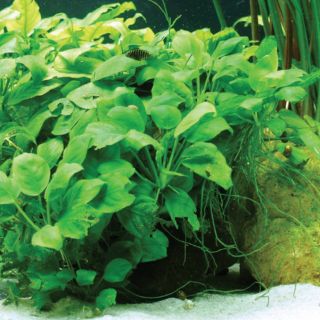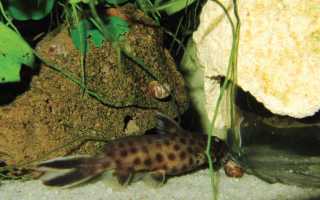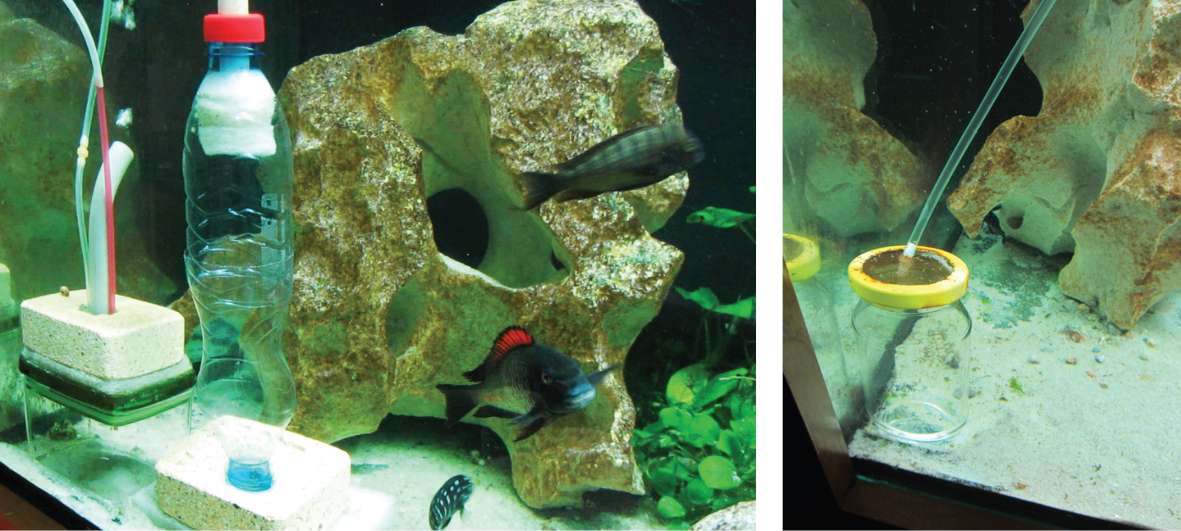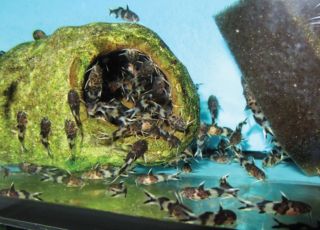(Part II) The blotched upside-down catfish (Synodontis petricola) is an attractive and interesting aquarium fish. Breeding them may require some patience, but with the right conditions and a bit of knowledge it is definitely possible.
(Continuation of the first part)
The fish are doing well
Contrary to the recommendations of some breeders from the Internet, I did absolutely nothing to breed the catfish. No special food, no frequent water changes, no temperature fluctuations or pH changes. Of course, I tried to gather as much information as possible about them before bringing them home.
To be honest, I secretly dreamed of breeding them and having a swarm of beautiful catfish swimming around the bottom of the aquarium - not just at night. I fed the Petricola at night with sinking granules from Nature Food, but this is not a requirement, leftovers from other fish would also suffice. Whatever the conditions in the tank, the catfish always came out of their hiding places to forage, especially at dusk.
One evening, as I was about to throw the usual dose of granules into the tank, I saw two Petricola start playing with each other. One of the fish was clearly a pregnant female. The two fish began to chase each other, but every now and then they slowed down because the male was trying to touch the female's head with his trembling body. As I watched them so enthusiastically, I suddenly realized that it was already after 2 a.m. and I had prepared nothing at all for the eventual care of the spawn. I could only continue to observe them. I tried to console myself at the time that this would happen again due to the reproductive instinct and I would then be better prepared for the situation.Entgegen der Empfehlung einiger Züchter aus dem Internet habe ich für die Zucht der Welse überhaupt nichts getan. Kein spezielles Futter, kein häufiger Wasserwechsel, keine Temperaturschwankungen oder pH-Wert-Änderungen. Natürlich habe ich versucht, so viele Informationen wie möglich über sie zu sammeln, bevor ich sie nach Hause brachte.
Preparation
It took me three days to prepare thoroughly. I took a plastic bowl and placed a grate with eight millimeter holes in it, on which the glass marbles were to be placed. Here a small problem arose. There was no way to get them in my area. Finally, I had to go all the way to Prague to get them. Just by the way: The man I finally got the marbles from, who sold me about seventy of them, was the European marble champion. How many times have I told myself since that this very fact could have been the main reason why my Petricola multiplied.
Having approached it this way, another question arose. What is the best way to create a special hiding place that forms an intimate space above the grate with the marbles, where the mating fish have the necessary peace and quiet and are not disturbed by the other inhabitants of the tank? Although I had dozens of flower pots at my disposal (my wife had the same interest in flowers as I did in Tanganyikan fish), they didn't seem to me to be the right thing for what I envisioned in my aquarium. Finally, I modeled the desired shape from ceramic material, which I fired in a ceramic kiln.

Overgrown cave

Cave
Cave
I thought the catfish would like that better than a flowerpot. In reality, though, I knew they didn't care. So, three days after I noticed the Petricola's courtship, the "spawning ground" I had prepared was placed in the tank, near the spot where the catfish spent most of their time, i.e. between the tuff stones overgrown with Anubias nana.
My contraption contained a plastic bowl with a grate, filled with black glass marbles, so that the eggs could fall through the spaces without the parents eating them. A ceramic cover with a hole was placed on this bowl. The next day, late in the afternoon, when I came home, I couldn't believe my eyes, there was a small pile of eggs on the bottom of the plastic bowl.
Spawning
Not only did the Petricola not wait for me to come back from work and observe them, but they also did not wait for the nightly quiet. Also, the aquarium was fully lit from early morning - like every day when I go to my office. I assumed that the fish had chosen this time on purpose or couldn't wait to try out the "European Champion's" marbles. No, no, later they spawned again in the late afternoon hours and I began to believe that this might become the rule with them. The "later" mentioned above means another day and then another day after that. Each time it happened before dusk. If you read carefully, you may wonder how it can be that the same pairs spawned again within three days. You see, I forgot to mention that in the meantime I was back in Krakow and again did not come home empty-handed!

After spawning
Selection of eggs
However, the euphoria soon wore off when I realized that I had to solve the potential problem of fungal infestation of the eggs. These catfish are not among the fish that care for their spawn, but on the contrary, they like to eat their spawn.
According to the available sources, the ubiquitous spores of the fungal genera Achyla and Saprolegnia are the cause. These fungal spores infect damaged, diseased or unfertilized eggs and can spread from these to healthy eggs and eventually kill the developing embryo. Many fish species protect their spawn, clean it and remove bad eggs. These catfish do not.
The next morning I got up an hour earlier to take care of the spawn. It was relatively easy to tell which eggs were okay and which were not. About ten percent of the bad, white eggs were bad, the other, good ones, had an ochre-honey color.
To remove the white, unfertilized eggs, I used a classic glass pipette. I sucked up a clump of eggs and shook it gently to separate the eggs from each other. This way I managed to separate the bad eggs from the good ones. I thought this was the best way to take care of the spawn. Maybe I should have used methylene blue, but I didn't.
After repeated "cleaning", about every six hours over a period of two days, I went from about 600 eggs down to a sixth, which began to hatch after two days. I tried various devices, from very simple mason jars placed in the main tank and connected to clean water from an external filter, to more "sophisticated" devices, as you can partially see in the attached picture.
The beaker proved useless. Most of the eggs clumped together, which led to mold formation. I think the reason for this was mechanical abrasion. The other devices worked well. Finally, I managed to save about 200 eggs from several spawns. I transferred these to a 35-liter aquarium with a cave.

Device for hatching eggs
Feeding
The next challenge was to figure out when they would digest their relatively large yolk sacs. So when to start feeding and what kind (size) of food to offer the fry so they could swallow it. They seemed to be very small! Here I made another mistake.
With a magnifying glass, I constantly followed the digestion of the yolk sacs of the embryos. I didn't want to wait any longer because I thought now was the right time, and on the fifth day I started feeding freshly hatched Artemia nauplii. However, this led to the loss of some fry in the following days. The main reason for this problem may have been overfeeding and the resulting deterioration of water quality rather than a hasty start to feeding.
The next test was to feed with paramecium. The very next day followed feeding with freshly hatched Artemia nauplii together with paramecium. So I finally continued feeding this way and only occasionally varied the food with microworms. The water temperature for rearing was between 23 - 24 °C.
Later I also started adding powdered dry food. I also tried using frozen Cyclops, but the little fish were obviously reluctant to accept these. What worried me most was that the fry were not very eager to come to the food. Most of the time they hid in the cave and only approached the food very cautiously. Finally, I found out that it was due to the too intense light. Whenever I dimmed the light, they came out of their hiding place. I then couldn't believe my eyes how many of these catfish were crammed together in the limited space of the cave. So as soon as the light went out, the whole swarm immediately rushed out and the little fish immediately started eating everything that even slightly smelled to them. Every second or third day I changed half of the water, as the volume of the tank was quite small in relation to the number of fry. At the age of four months, the fry reached a length of 2.5 - 3 cm.

S. petricola - juveniles
Conclusion
As I write this article, a new batch of eggs is hatching. This time I was more patient about starting the feeding, and I also tried to omit the feeding with infusoria. While I don't believe paramecium is harmful as a first food, I wanted to find out if it was necessary.
Synodontis petricola prefers larger tanks with plenty of hiding places. They often swim out to feed during the day as well, especially when it is quiet and the light is dim. In the company of Tropheus they do not manage to catch food and feed on leftovers. The water in my aquarium is buffered with salts and sodium bicarbonate. The water temperature is between 23 - 24 °C, the conductivity between 400 - 600 µS/cm.
These catfish do not require any special food. In my experience, they spawn several times a month. Then follows a break of several weeks, a connection of the spawning time with the conditions in their homeland I have not found. The usual time for spawning was late afternoon, the number of eggs from one spawning is about 500. About 10% of these were unfertilized or defective. However, the final result always depended on how successfully the problems with fungal infestation of the spawn could be eliminated. This, in my experience, is the crucial moment in obtaining young fish. The best food for the fry in the first two months after hatching is freshly hatched Artemia nauplii, followed by fine dust from normal food. The fry most like peace and quiet and subdued light.
Note: The article appeared in April 2012 in the bulletin "TANGANIKA MAGAZYN No. 11", a year later in the magazine Cichlidofili. Translated from the English version by Honza Burzanovský.
Author's postscript after ten years
As already mentioned, the article is about my beginnings with Petricola in 2011, i.e. ten years ago. Since then, I have gained a lot of experience, both through my own observations in keeping and breeding and through information from the Internet, which at the beginning of my time with Petricola, unlike today, was scarce. We decided with Honza to leave the original version as a reminder of this time. Perhaps you were amused while reading and looking at some of the pictures, what a madman like me can conjure up (make "on the knee" from today to tomorrow) and take on (trip to Prague for black glass marbles).
Above all, I would like to use this last paragraph to summarize my ten years of experience:
Synodontis petricola is no longer difficult to breed, as stated in the title of the article. Many aquarists can breed them today, or a few surviving specimens turn up in a community tank if there are enough hiding places there.
- it is not demanding in terms of food, as a nocturnal cleaner it eats the leftovers on the bottom, the question is how much this nocturnal cleaning bothers the fish that want to rest at night
- water parameters as for the other inhabitants of Lake Tanganyika
- no special preparation phase is necessary before spawning, sooner or later the females become clearly round and spawn, from one female there are also several hundred eggs
- with me they always spawned before sunset
- I have not used any hormones. The reproductive drive is so strong even without it that they will eventually spawn everywhere if there is no hiding place
- the biggest problem, perhaps the only one, is the fight against the "white spot disease", which destroys the entire spawn if you can't deal with it. For me, no medications or chemicals, not even a UV lamp, have helped significantly. The physical separation of the affected eggs in the first at least two days after spawning seems to be crucial. Of course, the eggs must have access to oxygen by being washed around by oxygen-rich water.
- the growth of the fry is slow, this is related to the fact that it is a long-lived fish. To illustrate: With me, these fish, which were caught in the vicinity of Chaitika as adults, are already ten years old and still vital and spawn regularly. René Kruter, a Dutch aquarist and friend who preceded me and was the first to breed them in Europe, brought them from Lake Tanganyika 25 years ago, he still has them today and breeds them occasionally.
Acknowledgments
The author would like to thank Marta Mierzenská for her advice and his son David for his help with the photography. Finally, Honza Burzanovský for persuading me to dust this off and for translating from English and collaborating.
Materials used
- Burnside G., 2009, The Spawning and Raising of the Pygmy Cat, Synodontis petricola, December 13, 2009 © Scot.Cat., 1997-2011, burnside@madasafish.com
- Maznyk P, Avoid Being a Nervous Fishkeeper, March 2009, KWAS - Kitchener Waterloo Aquarium Society, pmaznyk@rogers.com
- Reimer K., January 2008, Breeding & Raising Synodontis petricola. (KWAS), Kevin.Reimer@sympatico.ca
- Walker H., Walker D., 2009, Spawning Synodontis petricola, Missouria Aquarium Society web site, http://www.missourlaquariumsociety.org
- Riegel J., 2008, Synodontis petricola Spawning Report, Fincinnati, the official newsletter of the Greater Cincinnati Aquarium Society Aquarticles, http://www.aquarticles.com
